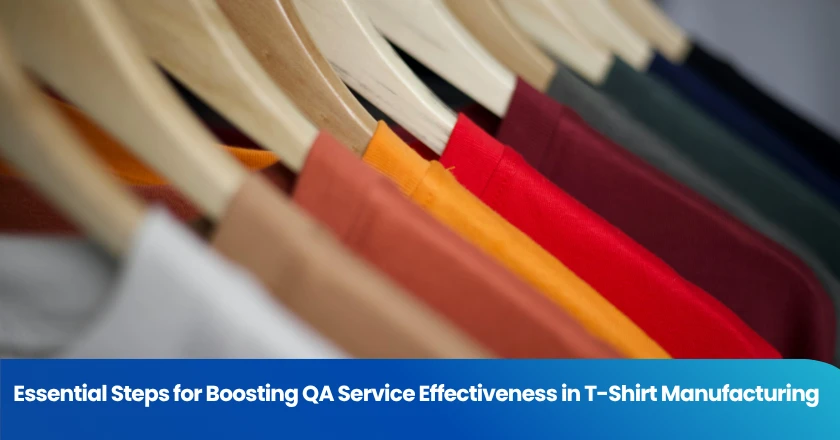
When you dive into t-shirt manufacturing, outsourcing can open the door to bigger opportunities. You want every t-shirt in your clothing line to meet high quality standards. That’s where qa services step in. Strong quality control keeps your clothing production on track and helps you avoid costly mistakes. Open communication with your partners makes sure everyone understands your goals for t-shirt production. Treat qa services as a smart investment. With the right approach, you can grow your t-shirt business, build trust in your clothing, and set yourself up for success in t-shirt manufacturing.
Key Takeaways
• Set clear, measurable quality standards for your t-shirts to guide production and avoid costly mistakes.
• Maintain strong communication with your outsourcing partners through regular updates and quick issue resolution.
• Choose QA service providers with relevant experience and values that match your brand for better results.
• Involve your QA team early in the production process to catch problems before they grow and keep quality on track.
• Use digital tools and ongoing inspections to monitor production in real time and improve efficiency continuously.
Quality Standards
Measurable Criteria
You want every t-shirt to meet your expectations, especially when you use outsourcing for clothing manufacturing. Setting clear, measurable quality standards helps you keep control over your production. Start by listing what matters most for your t-shirt line. Think about fabric strength, stitching, color consistency, and print clarity. These details make a big difference in clothing quality. Use numbers and specific descriptions. For example, you might require a certain thread count or a minimum colorfastness rating. This approach helps you avoid extra costs from rework or returns. It also supports cost savings by reducing waste in your supply chain. When you define these criteria, you give your outsourcing partners a clear target. This makes quality control much easier during every stage of production.
Tip: Create a simple table to track your quality standards for each t-shirt style. This helps you and your partners stay on the same page.
| T-Shirt Feature | Standard | Measurement Method |
|---|---|---|
| Fabric Weight | 180 gsm | Digital Scale |
| Stitch Density | 10/inch | Manual Count |
| Colorfastness | 4/5 | Wash Test |
Communication with Partners
Strong communication keeps your outsourcing clothing manufacturing process running smoothly. You need to share your quality standards with every partner in your supply chain. Hold regular meetings to review production updates and address any issues. Use clear language and visual aids when you explain your requirements. This helps avoid misunderstandings that can lead to extra costs or delays. Good communication also supports better supply chain management and cost control. If you spot a problem, act fast. Quick feedback helps your partners fix issues before they affect your t-shirt production. When you build trust through open communication, you improve quality and keep your clothing line on track.
QA Services Selection
Expertise Evaluation
You want your t-shirt manufacturing to run smoothly. Choosing the right qa services makes a big difference in your clothing production. Start by looking at the experience of each provider. Ask about their background in t-shirt manufacturing and outsourcing. Check if they have handled projects similar to your clothing line. You can request examples of past work or ask for details about their process. This helps you see if they understand the unique needs of t-shirt production. Providers with strong expertise can spot quality issues early and help you avoid extra costs.
Tip: Make a checklist of skills and experience you want in your qa services partner. This keeps your selection process focused.
Reference Checks
You should always check references before you choose a qa services provider for your t-shirt production. Reach out to other companies who have used their services for outsourcing. Ask about their experience with quality control, cost management, and communication. Did the provider help reduce costs or improve the quality of their clothing? Were there any problems during production? Honest feedback from others in the t-shirt manufacturing industry can help you avoid costly mistakes. Reference checks give you a real-world view of how the provider supports your brand and production goals.
Brand Alignment
Your brand stands for something special in the t-shirt market. You want qa services that match your brand values and quality standards. Talk with each provider about your expectations for clothing quality, production timelines, and cost control. Make sure they understand your goals for outsourcing and t-shirt manufacturing. When your qa services partner aligns with your brand, you get better results. Your clothing production runs smoother, costs stay under control, and your t-shirt line keeps its reputation for quality.
Note: A strong partnership with your qa services provider helps your brand grow and keeps your t-shirt production on track.
Early QA Integration
Getting your QA team involved early in the outsourcing process can make a huge difference in t-shirt manufacturing. You want to catch problems before they grow. Early integration gives you more control over clothing quality and helps you avoid surprises during production. When you start with QA from the beginning, you set the tone for the whole project. You also gain more flexibility to adjust your production plans if needed.
Pre-Production Planning
You should bring your QA team into the conversation before production starts. This step lets you set clear expectations for t-shirt quality and control. You can review the outsourcing plan together and spot any risks in clothing manufacturing. Early planning helps you build a strong foundation for production oversight. You also get more production flexibility because you can make changes before any fabric gets cut. Your team can create checklists and timelines that keep everyone on track.
Tip: Use a simple checklist to make sure you cover every detail in pre-production planning. This keeps your outsourcing process smooth.
Sample Approval
Sample approval is a key part of quality control in t-shirt manufacturing. You should always ask for physical samples before full production begins. This step lets you check the clothing for stitching, color, and fit. If you see any issues, you can ask for changes right away. Sample approval gives you more control over the final product. It also helps you avoid costly mistakes in outsourcing. You want every t-shirt to match your standards before you move forward.
Ongoing Inspections
Don’t wait until the end of production to check your t-shirts. Ongoing inspections help you catch problems early and keep quality high. You can schedule regular checks at different stages of clothing manufacturing. This approach gives you more control and flexibility. If you find an issue, you can fix it before it affects the whole batch. Ongoing inspections also support better production oversight and help you manage outsourcing risks. You want every t-shirt to meet your quality goals from start to finish.
Communication & Collaboration
Strong communication and coordination keep your t-shirt manufacturing on track. When you work with outsourcing partners, you need to make sure everyone understands your goals. Good communication and coordination help you avoid mistakes, control costs, and protect your brand. Let’s look at how you can use regular updates, issue escalation, and feedback loops to boost quality and cost savings in your t-shirt production.
Regular Updates
You want your t-shirt production to run smoothly. Regular updates help you track every step in the manufacturing process. Set up weekly calls or send out progress reports. This keeps your outsourcing partners in the loop. You can spot problems early and make changes fast. Regular updates also help you manage costs and supply issues. When you stay informed, you keep your brand strong and your t-shirt line consistent.
Tip: Use a simple table to track updates from each outsourcing partner. This helps you see where your t-shirt production stands.
| Partner | Update Date | Production Stage | Issues Found | Actions Needed |
|---|---|---|---|---|
| Partner A | 6/1 | Cutting | None | Continue |
| Partner B | 6/2 | Printing | Color mismatch | Adjust ink |
Issue Escalation
Sometimes, problems pop up in t-shirt manufacturing. You need a clear plan for issue escalation. If you find a quality control problem, act fast. Tell your outsourcing partner right away. Set clear steps for fixing the issue. This saves time and keeps costs down. Quick action protects your brand and helps you avoid bigger supply chain problems. Good issue escalation shows your partners that you care about quality and cost savings.
Feedback Loops
Feedback and improvement drive your t-shirt production forward. After each production run, ask for feedback from your outsourcing partners. Share your own feedback, too. This open communication helps everyone learn and grow. You can spot ways to improve quality, cut costs, and boost flexibility. Feedback loops also support better management and supply planning. When you listen and respond, you build trust and keep your brand at the top of the t-shirt market.
Remember: Strong communication and coordination lead to better t-shirt quality, lower costs, and a more flexible supply chain.
Quality Control Tools
You want your t-shirt manufacturing to run smoothly. Quality control tools help you keep every step of production on track. When you use outsourcing, these tools give you more control and help you spot problems fast. Let’s look at how digital reporting, real-time monitoring, and data-driven improvement can boost your efficiency and quality.
Digital Reporting
Digital reporting makes your outsourcing process easier. You can collect data from every stage of manufacturing and see it in one place. This helps you track production progress and spot any issues with quality. Many digital platforms let you upload photos, checklists, and test results. You get a clear view of your t-shirt production without waiting for paper reports. Digital reporting also helps you share updates with your team and partners. You save time and improve efficiency.
Tip: Set up automatic alerts for any quality issues. This way, you can act fast and keep your production on schedule.
Real-Time Monitoring
Real-time monitoring lets you see what’s happening in your manufacturing process right now. You can use sensors or cameras to watch key steps in production. This is very helpful when you use outsourcing for t-shirt manufacturing. You catch problems as soon as they happen. You can fix defects before they affect the whole batch. Real-time monitoring keeps your production moving and helps you meet your quality goals.
• Watch fabric cutting and stitching live
• Track print quality as shirts move down the line
• Get instant updates on any delays or defects
Data-Driven Improvement
You can use data to make your manufacturing better. When you collect information from digital tools, you see patterns in your production and outsourcing. You might notice that certain steps cause more defects. You can focus on fixing those areas to boost efficiency and quality. Data-driven improvement helps you make smart choices for your t-shirt manufacturing. You keep your production strong and your outsourcing partners on the same page.
Remember: The more you use data, the easier it gets to improve your production and reach your quality targets.
Continuous Improvement
You want your t-shirt manufacturing to get better with every production run. Continuous improvement helps you keep your brand strong and your customers happy. Let’s break down how you can use QA results, take action, and train your team for success in outsourcing.
QA Results Analysis
Start by looking at the results from your QA checks. You can spot patterns in your manufacturing process. Maybe you see the same stitching issue in every batch. This tells you where to focus your attention. Use simple charts or tables to track these results. When you review your data, you make smarter decisions for your brand. You also boost efficiency in your production. Outsourcing partners will appreciate your clear feedback.
Tip: Keep a log of every QA result. This helps you see trends over time and keeps your brand ahead in the market.
Corrective Actions
When you find a problem, act fast. Corrective actions keep your production on track and protect your brand’s reputation. You might need to adjust a step in your manufacturing process or update instructions for your outsourcing partner. Quick fixes stop small issues from becoming big ones. Your brand stands out when you show you care about quality. Every action you take builds trust with your customers and your team.
• Identify the issue
• Decide on the best fix
• Share the solution with your outsourcing partner
Training for Teams
Your team needs the right skills to keep your brand at the top. Regular training helps everyone understand your quality goals. You can hold short workshops or share videos that explain new production methods. Training also helps your outsourcing partners stay up to date. When everyone knows what to do, your manufacturing runs smoother. You see fewer mistakes, better efficiency, and stronger results for your brand.
Remember: A well-trained team supports your brand’s growth and keeps your production moving forward.
You want to grow your t-shirt business and stand out in the t-shirt market. Focus on strong quality control, clear communication, and continuous improvement in every step of your manufacturing. Outsourcing gives you flexibility, but you need to set clear standards for your t-shirt production. Review your current outsourcing and manufacturing processes. Take action to refine your approach. When you keep your brand goals in mind, you can grow your t-shirt business and deliver custom t-shirts that impress. Outsourcing done right helps you grow your t-shirt business and build a trusted brand in t-shirt manufacturing.
FAQ
What is the most important step in QA for t-shirt manufacturing?
You need to set clear, measurable quality standards first. This step gives you and your partners a shared goal. It helps you catch problems early and keeps your production on track.
How often should you inspect t-shirts during production?
You should schedule inspections at every key stage—cutting, printing, and finishing. Regular checks help you spot issues before they grow. This approach saves you time and money.
Why should you use digital tools for quality control?
Digital tools let you track production in real time. You can spot defects quickly and share updates with your team. This makes your process faster and more reliable.
How do you handle quality issues with an outsourcing partner?
Act fast when you find a problem. Tell your partner right away and agree on a fix. Quick action keeps your production moving and protects your reputation.
What training should your team have for better QA?
Your team should know your quality standards and how to use QA tools. Short workshops or videos work well. Training helps everyone stay sharp and reduces mistakes.
Grow your business with TradeAider Service
Click the button below to directly enter the TradeAider Service System. The simple steps from booking and payment to receiving reports are easy to operate.



